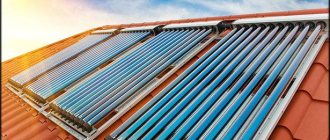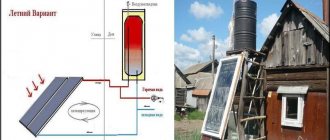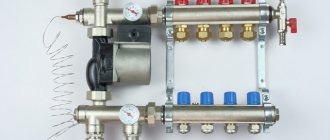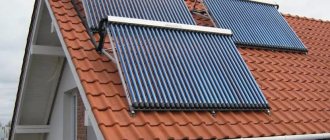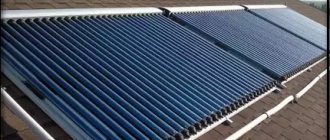Solar energy is not just about light converted into electricity. It also provides hot water and warmth in the house. To convert the energy of solar radiation into heat, special installations are needed - solar collectors. From April to October, these installations supply homes with hot water, and in the autumn-winter period, together with traditional energy sources, they heat the premises.
For owners of cottages and country houses, the use of solar collectors provides significant cost savings, since hot water enters the house almost free of charge. But in order for these installations to operate in the most optimal mode, before choosing the type of installation and its location, it is necessary to perform at least an approximate, rough calculation of the solar collector for hot water supply (hot water supply).
Efficiency
Solar collectors, or solar systems, can operate all year round without interruption.
Even in cloudy conditions, more than half of the radiation reaches the earth's surface. In addition, their operation is absolutely safe for humans and the environment. Any helio kit is easy to maintain, looks aesthetically pleasing, and improves the appearance of a private home. The advantages of the devices also include:
- autonomy of hot water supply in winter, summer, during interruptions and repair work;
- service life up to 30 years, payback with benefits from heating costs in 3-5 years;
- no tariffs, monthly calculations are independent of increases in electricity prices;
- possibility of simultaneous use for heating swimming pools, greenhouses, utility rooms;
- easy integration into an existing heating kit;
- absence of dirt, waste;
- reducing the total load on the electrical and heating networks of the house;
- optimization for your own needs.
The negative aspects of using solar collectors are not so numerous:
- high cost of initial purchase and installation. Depending on the manufacturer, scale and configuration, the entire solar system can cost up to 10 thousand dollars. Even simpler models cost a large sum, which must be paid at a time;
- The efficiency of collectors can be influenced not only by climatic conditions, but also by landscape features, roof shape, typical daylight hours and other factors. The payback period depends on such indicators.
Passive circulation within the solar collector will result in lower derivative efficiency. With forced control, water and energy are spent more productively. The second option requires more complicated maintenance, but is more suitable for middle-class living conditions. For southern regions, the introduction of a solar system often reduces electricity bills by half.
The efficiency of the solar collector reaches 95%. Regions with harsh climates show a lower indicator, but also justify their use. To calculate the annual efficiency of a collector, you need to multiply the amount of insolation in the region for the year (there are special tables), the absorption area of the system and its efficiency. The daily benefit is calculated in the same way, but taking into account the corresponding (daily) insolation indicator.
A story about a collector in winter
Advantages and disadvantages
Like any technical device, the solar collector has its pros and cons, both in terms of the possibility of use and operation, and in terms of other parameters and indicators. Depending on the design of the device, the pros and cons vary, so it is necessary to consider them separately from each other.
Flat solar collectors.
Advantages of use:
- When used in southern regions with warm climates, the best indicators in the price-performance ratio;
- During precipitation in the form of snow, they have the ability to self-clean;
- They have high efficiency when used in summer;
- Relatively low cost in comparison with analogues of other designs.
The disadvantages are:
- Significant heat losses caused by the design features of the device;
- Low efficiency when working in the autumn-spring period;
- Difficulty in transporting and installing finished products;
- The high windage of the structure creates a risk of damage to its elements during operation;
- Difficulty and labor-intensive repair work.
Vacuum solar collectors.
Advantages of use:
- When used in regions with cold and temperate climates, the best indicators in the price-performance ratio;
- Insignificant heat losses during operation, in comparison with analogues of other designs;
- Ability to work at low and negative ambient temperatures;
- Ability to work in low solar activity in the morning and evening hours, as well as in the absence of direct sunlight (cloudy weather);
- Easy and convenient installation, transportability of structures;
- Reliability during operation.
The disadvantages are:
- Relatively high cost;
- Strict installation requirements that determine the location of the collector in space in relation to the surface of the earth.
Self-assembly
To begin creating a vacuum manifold, you need to assemble the frame. It is advisable to install it immediately where the future heating complex will be located. The dimensions of the frame depend on the planned characteristics of the future system and the model being assembled. As a rule, detailed instructions are specified in the instructions supplied with the components.
Example project for assembly:
When assembling the frame on the roof, it is additionally reinforced with sealant in the contact areas. This is necessary to protect against water ingress through the mounting holes. Next, the storage tank is put in place and attached to the frame.
Next, the air vent, heating element and temperature sensor (if equipped) are installed. All components are installed on softening pads (must be included in the kit). After this, it is necessary to connect the building’s water communications to the system - for this, fittings and pipes made of polypropylene are usually used; such fittings are quite durable, durable and can be easily replaced if they fail. Pipes must withstand temperatures up to 95 degrees.
When the water supply is connected, water is poured into the storage tank and the tightness of the complex is checked for several hours. If leaks are found, they should be repaired immediately. The final stage is the installation of heating modules. A copper tube is placed in a vacuum glass flask, and the structure is fixed from below with a cup and a rubber boot. The tip of the copper tube is pushed into the brass condenser until it stops, then the locking mechanism snaps onto the bracket.
The installation of the remaining tubes follows the same principle.
After this, the mounting block (if provided) is connected to the system. It is supplied with power from a 220 V network. Auxiliary modules are also connected - temperature sensor, air exhaust and heating element. At the final stage, the control controller of the complex is installed (also if provided). The necessary settings are made into it, after which the new heating system starts working as usual.
All the main parts can be assembled yourself. But if you have no experience in plumbing and installation work, it is better to turn to factory components, since a complex assembled “from scratch” may contain significant flaws and not provide the required efficiency. On the Moscow market, a ready-made set of a heater for 30 vacuum tubes connected to a cold water supply with a tank with a volume of 260 liters costs about 90 thousand rubles.
Where is the best place to place it?
For effective and complete operation, the vacuum solar collector must be correctly placed and oriented to the cardinal points. In northern latitudes, it is advisable to install the device on the sunny side of the land or in the southern part of the roof. If it is not possible to orient exactly to the south, you should choose the most illuminated position in the direction of the west or east.
Solar collector: types and subtypes of coolants
Depending on the temperature the collector plates can reach, they can be divided into the following types:
- Low temperature manifold;
- Medium temperature collector;
- High temperature collector.
A low-temperature solar collector will not be able to provide high-power energy. It will be able to heat water no warmer than 500 C.
Medium-temperature collectors can heat water up to 850-900 C. Such solar collectors are most optimal for heating a home and premises.
And high-temperature collectors are in great demand in industrial enterprises and large plants, so it is simply not possible to make them on your own.
Type of solar collector
All integrated solar energy carriers are divided into:
- Flat solar collectors;
- Air manifolds;
- Liquid energy carriers;
- Storage integrated solar collectors.
Thermosyphon solar coolant
Storage integrated solar collectors are also called thermosyphon collectors. Its main purpose is not only to heat water, but also to maintain the desired temperature for a certain time. These collectors do not have pumps, so they are much cheaper than other varieties.
The thermosyphon solar collector is manufactured in the form of a structure with one tank, which is filled with water and placed in a heat-insulating box. On top of the tank there is a glass cover, through which solar radiation passes through the glass and heats the water.
The only drawback of a solar collector is that it is unlikely to be used to its full potential in winter.
Flat coolant
Scheme of heating water in a boiler using a solar collector
A flat-plate solar collector looks like a regular flat metal box, inside of which there is a black plate through which solar energy passes.
The glass cover of the box accumulates solar radiation. Since glass has a low iron content, all the accumulated energy is transferred to the plate.
The flat-plate collector box is thermally insulated, and the black plate is thermally sensing, so heat is released from this design. And since the efficiency of the plate is no more than 10-15%, it is additionally coated with an amorphous semiconductor.
Flat energy carriers are designed for heating water in saunas, swimming pools, as well as for heating living rooms and other domestic needs.
Liquid solar collector
A liquid solar collector can be either glazed or unglazed. And also with a closed or open heat exchange system. But they are all united by the principle of operation of the coolant, which is based on liquid.
Air coolant
Scheme of drying grain using a solar collector
An air solar collector vaguely resembles the operation of a liquid collector. But it takes much less money to install and purchase it. In addition, air coolants do not freeze at negative air temperatures and do not leak.
Airborne solar collectors are good for drying agricultural products.
Concentrate
In addition to all the above types and subtypes of solar collectors, concentrators are also distinguished. The main distinguishing feature of concentrates from collectors is the concentration of solar radiation. This seems possible due to the mirror surface of the structure, thanks to which the sun's rays are directed to the absorbers.
The most significant disadvantage of this type of collector is the inability to function normally on bad weather days.
That is, concentrates are only suitable for work in countries where the climate is constantly hot.
Solar oven and distiller
And the last type of solar collectors can be considered furnaces powered by solar radiation and distillers. The operating principle of distillers is to evaporate water. Thus, they not only provide heat energy, but also purify water. Solar ovens also work using the same algorithm.
Power generation
Solar energy works by converting sunlight into electricity. This can happen either directly, using photovoltaics, or indirectly, using concentrated solar power systems, in which lenses and mirrors collect sunlight from a large area into a thin beam, and a tracking mechanism tracks the position of the Sun. Photovoltaics converts light into electric current using the photoelectric effect.
Solar power is projected to become the largest source of electricity by 2050, with photovoltaics and concentrated solar power accounting for 16% and 11% of global electricity production, respectively.
Commercial concentrated solar power plants first appeared in the 1980s. After 1985, the 354 MW installation of this type of SEGS in the Mojave Desert (California) became the largest solar power plant in the world. Other solar power plants of this type include SES Solnova (150 MW) and SES Andasol (100 MW), both in Spain. Among the largest photovoltaic power plants are Agua Caliente Solar Project (250 MW) in the USA, and Charanka Solar Park (221 MW) in India. Projects larger than 1 GW are in the development stage, but most photovoltaic installations, up to 5 kW, are small in size and located on rooftops. As of 2013, solar power accounted for less than 1% of the global grid.
Structural drawings
Let's get started
Before building a solar collector, it is necessary to make the appropriate calculations and determine how much energy it should produce. But you shouldn’t expect high efficiency from a homemade installation. Having determined that there will be enough of it, you can begin.
The work can be divided into several main stages:
- Make a box
- Make a radiator or heat exchanger
- Make a front camera and storage device
- Assemble the collector
To make a box for a solar collector with your own hands, you should prepare an edged board 25-35 mm thick and 100-130 mm wide. Its bottom should be made of textolite, equipped with ribs. It should also be well insulated using polystyrene foam (but preference is given to mineral wool), covered with a galvanized sheet.
4 more effective ways to alternatively heat your home
Which you can learn about in our next article.
Having prepared the box, it’s time to make the heat exchanger. You should follow the instructions:
- It is necessary to prepare 15 thin-walled metal tubes 160 cm long and two inch pipes 70 cm long
- In both thickened tubes, holes are drilled with the diameter of the smaller tubes into which they will be installed. In this case, you need to ensure that they are coaxial on one side, the maximum step between them is 4.5 cm
- The next stage is that all the tubes need to be assembled into a single structure and welded securely
- The heat exchanger is mounted on a galvanized sheet (previously attached to the box) and fixed with steel clamps (metal clamps can be made)
- It is recommended to paint the bottom of the box in a dark color (for example, black) - it will better absorb solar heat, but to reduce heat loss, the external elements are painted white
- To complete the installation of the collector, it is necessary to install a cover glass near the walls, while not forgetting about reliable sealing of the joints
- A distance of 10-12 mm is left between the tubes and the glass
All that remains is to build a storage tank for the solar collector. Its role can be played by a sealed container, the volume of which varies about 150-400 l
. If you cannot find one such barrel, you can weld several small ones together.
Like the collector, the storage tank is thoroughly insulated from heat loss. All that remains is to make a fore-chamber - a small vessel with a volume of 35-40 liters. It must be equipped with a water-falling device (a swivel valve).
The most responsible and important stage remains - to assemble the collector together. You can do it this way:
- First you need to install the front camera and storage. It is necessary to ensure that the liquid level in the latter is 0.8 m lower than in the front chamber. Since a lot of water can accumulate in such devices, it is necessary to think about how they will be reliably shut off
- The collector is placed on the roof of the house. Based on practice, it is recommended to do this on the south side, tilting the installation at an angle of 35-40 degrees to the horizontal
- But you need to take into account that the distance between the storage tank and the heat exchanger should not exceed 0.5-0.7 m, otherwise the losses will be too significant
- At the end, the following sequence should be obtained: the front camera must be located above the drive, the latter - above the collector
The most important stage is coming - it is necessary to connect all the components together and connect the water supply network to the finished system. To do this, you will need to visit a plumbing store and purchase the necessary fittings, adapters, sockets and other shut-off valves. It is recommended to connect high-pressure sections with a pipe with a diameter of 0.5 inches, low-pressure sections with a diameter of 1 inch.
Commissioning is carried out as follows:
- The unit is filled with water through the bottom drainage hole
- The anterior chamber is connected and the fluid levels are adjusted
- It is necessary to walk along the system and check that there are no leaks
- Everything is ready for everyday use
Radiation distribution at the boundary of the atmosphere
For climatology, the question of the distribution of influx and output of radiation across the globe is of significant interest. Let us first consider the distribution of solar radiation on a horizontal surface “at the boundary of the atmosphere.” One could also say: "in the absence of atmosphere." By this we assume that there is no absorption, no scattering of radiation, no reflection of it by clouds. The distribution of solar radiation at the boundary of the atmosphere is the simplest. It really exists at an altitude of several tens of kilometers. This distribution is called solar climate. It is known how the solar constant and, therefore, the amount of radiation coming to the Earth changes throughout the year. If we determine the solar constant for the actual distance of the Earth from the Sun, then with an average annual value of 1.98 cal/cm2 min. it will be equal to 2.05 cal/cm2 min. in January and 1.91 cal/cm2 min. in July.
Therefore, during a summer day, the northern hemisphere receives slightly less radiation at the boundary of the atmosphere than the southern hemisphere during its summer day.
The amount of radiation received per day at the boundary of the atmosphere depends on the time of year and the latitude of the place. Under each latitude, the time of year determines the duration of the influx of radiation. But at different latitudes, the duration of the daytime part of the day at the same time is different.
At the pole, the sun does not set at all in summer, and does not rise for 6 months in winter. Between the pole and the Arctic Circle, the sun does not set in summer and does not rise in winter for a period of six months to one day. At the equator, the daytime part of the day always lasts 12 hours. From the Arctic Circle to the equator, daylight hours decrease in summer and increase in winter.
But the influx of solar radiation onto a horizontal surface depends not only on the length of the day, but also on the height of the sun. The amount of radiation arriving at the boundary of the atmosphere per unit horizontal surface is proportional to the sine of the height of the sun. And the height of the sun not only changes in each place during the day, but also depends on the time of year. The height of the sun at the equator varies throughout the year from 90 to 66.5°, in the tropics - from 90 to 43°, in the polar circles - from 47 to 0° and at the poles from 23.5 to 0°.
The spherical shape of the Earth and the inclination of the equator plane to the ecliptic plane create a complex distribution of radiation influx across latitudes at the boundary of the atmosphere and its changes throughout the year. In winter, the influx of radiation decreases very quickly from the equator to the pole, in summer it decreases much more slowly. At the same time, the maximum in summer is observed in the tropics, and from the tropics to the equator the influx of radiation decreases somewhat. The small difference in the influx of radiation between tropical and polar latitudes in summer is explained by the fact that although the heights of the sun in polar latitudes in summer are lower than in the tropics, the length of the day is long. On the summer solstice, the pole would therefore receive more radiation than the equator in the absence of an atmosphere. However, near the earth's surface, as a result of the attenuation of radiation by the atmosphere, its reflection by clouds, etc., the summer influx of radiation in polar latitudes is significantly less than in lower latitudes.
At the upper boundary of the atmosphere outside the tropics, there is one maximum of radiation in the annual cycle, which occurs at the time of the summer solstice, and one minimum, which occurs at the time of the winter solstice. But between the tropics, the influx of radiation has two maximums per year, occurring at those times when the sun reaches its highest midday height. At the equator this will be on the days of the equinoxes, in other intertropical latitudes - after the spring and before the autumn equinox, moving further away from the dates of the equinoxes, the greater the latitude. The amplitude of the annual cycle is small at the equator and small inside the tropics; in temperate and high latitudes it is much greater.
Device and types
Conventionally, these systems can be classified into two types
:
- liquid (which we talk about in this material);
- air solar collectors, which use heated air rather than liquid.
They are also divided according to efficiency, because they provide different heat transfer. It depends on the materials used to make the battery and its area. The optimal location for the absorber is the roof
:
- receives the maximum amount of sunlight,
- has a large area
- The battery installed on the roof does not take up any useful space and does not interfere with anyone.
Air solar collector
The design of the solar collector can be of several types, the main
:
- vacuum heating manifold, which has the most complex design. Vacuum solar collectors are excellent for heating rooms, heating water at any time of the year, they will completely provide a small house or cottage;
- A flat solar collector can be liquid or vacuum. This is the most common type because it is quite easy to install, yet it is efficient and can provide the house with the necessary amount of heat for heating the premises, and water for household needs;
- thermosiphon - glass or metal tubes are used as an absorber;
- tubular - the simplest type that can be made for a summer residence; it is quite primitive and not suitable for use in winter.
We are interested in a design that ensures the availability of hot water and heating in the house at any time of the year; we will focus on two optimal options, consider the design of a vacuum solar collector and a flat one.
Flat-plate collector
This is the most common type of collector that you can make yourself. Well suited for use in the warm season for heating water; in winter the efficiency decreases.
The design feature is as follows
:
- the body has a flat rectangular or square shape, made of metal or other material with a high thermal conductivity, coated with black paint;
- inside there is a plate in which a coil made of a copper tube of small cross-section is laid;
- coolant circulates through the tubes: water, propylene glycol, antifreeze, and other suitable liquids;
- also, thermal insulation material is placed inside the housing, which minimizes heat loss;
- When assembling a collector of this type, you need to stock up on a sheet of polycarbonate or glass, which will serve as a cover and perform two functions: prevent the penetration of debris and precipitation, and enhance heating.
Component of a flat-plate solar collector
Vacuum manifold
For water heating, vacuum-type solar collectors can be used. Thanks to their design features, they are more powerful: they are able to generate thermal energy, which is enough to heat water and heat rooms.
Design Features
:
- Tubes that are placed in flasks with the air pumped out allow to minimize losses;
- the tubes are covered on top with an absorption material that absorbs light energy, and inside they are filled with antifreeze (refrigerant);
- the ends of the tubes are connected to a pipe through which the coolant passes;
- when heated, the antifreeze boils and turns into steam, which, in turn, rises and heats the coolant;
- This design has a drawback: if at least one tube fails, repair becomes quite problematic, since they are connected in series. All the “internals” will have to be replaced.
Airborne solar system made of vacuum tubes
Such an air-air solar collector for heating will be more efficient and suitable for maintaining the temperature in the system in any season. Although in cold weather, the efficiency of a working collector may decrease slightly due to short daylight hours and low light activity.
Care tip! Pay attention to the inner surface of the water storage tank; it becomes covered with scale over time and needs cleaning. Frequency depends on the water quality in the area
How and what to make an air collector from
How to make reservoir calculations
- each m² of the collector area will provide 1.5 kW/hour of thermal energy, provided that the weather is sunny;
- To fully heat a room, 1 kW of thermal energy per 10 m² is required.
Materials for making the collector
- External block - assembled from plywood, chipboard and wooden blocks. In appearance it resembles an ordinary box.
- The bottom is made of corrugated board. The metal sheet is treated with special black paint with a high light absorption coefficient. An absorbent surface can be made from cut aluminum cans. The bottom is lined with insulating material to avoid heat loss.
- Radiator fins - used for better heat absorption. In production, thin sheets of aluminum and copper are used. You can install a ready-made radiator from an old refrigerator.
- The collector cover is made of cellular polycarbonate, which has good light transmittance and at the same time retains heat inside the collector. To save money, you can use ordinary glass as a coating. Thermal efficiency will be lower than that of collectors covered with polycarbonate.
- Thermal insulation of the body - the frame is sheathed around the perimeter with polystyrene foam.
What is the minimum width?
Dishwashers are divided into full-size and narrow:
- full size. The width of such machines is 55-60 cm, height 80-85 cm, depth 55-60 cm. The capacity of such equipment is up to 15 complete sets. In terms of dimensions, the machine practically corresponds to the parameters of a washing machine. This option is ideal for use at home, provided there is free space of this size;
- narrow. The width of dishwashers of this type is 45 cm, depth 51-65 cm, height 81-85 cm. This type of equipment is in greatest demand among consumers due to the universal volume of the dishwasher box, which holds 9-12 sets of dishes. In addition, such a machine will fit even in a small kitchen.
How it works in winter
In heating systems, as a rule, vacuum collectors are used, this is determined by their technical characteristics and operating conditions.
The main element of a vacuum solar collector is a vacuum tube, which consists of:
- An insulating tube made of glass or other material that transmits the sun's rays with minimal loss of their power;
- Copper heat pipe placed in the inner space of the insulating tube;
- Aluminum foil and absorbent layer located between the tubes;
- The cover of the insulating tube, which is a sealing gasket that provides a vacuum in the internal space of the device.
The system works as follows:
- Under the influence of solar energy, the coolant of the tube circuit evaporates and rises, where it condenses in the collector heat exchanger, transfers its heat to the coolant of the outer circuit, after which it flows down, and the process repeats.
- The external circuit coolant, from the solar collector heat exchanger, is supplied to the storage tank, where the resulting thermal energy is transferred to the coolant of the heating and hot water supply system.
- The circulation of the external circuit coolant is carried out by installing a circulation pump and automation systems that ensure the system operates in automatic mode.
- The automation system complex includes a controller, sensors and controls that ensure the established operating parameters of the system (temperature, liquid flow in the DHW system, etc.)
In order for this system to be effective and cope with the assigned tasks, including in winter, the system provides for the installation of backup energy sources. This may be an additional heating system using a coolant, as in the diagram above, when the additional circuit coolant is heated by using various types of fuel (gas, biofuel, electricity). Also, a similar task can be accomplished by installing electric heating elements directly into the battery tank. The operation of backup energy sources is controlled by an automation system, turning on these devices as needed.
Choosing a salt lamp
The stores offer a huge range of salt lamps, which come in various shapes and sizes. The shape of the lamp shade does not change its functionality, but the weight and size are directly related to the properties. The average weight of a salt lamp is 3 kg; such a device can work effectively on an area of up to 12 square meters. m. For a larger room, you should choose a large ionizer or purchase a chandelier that consists of several salt lamps.
Salt lamps come in a variety of colors. This characteristic is also important, since the scope of influence depends on the shade:
- White – cleansing, disinfection.
- Yellow – beneficial effect on the pancreas and liver.
- Orange – effectively cope with mental problems and restore the nervous system.
- Red - will improve blood circulation and have a positive effect on the cardiovascular system.
- Pink – will create an intimate atmosphere and increase emotionality.
- Brown – promotes harmony with the outside world.
Principle of operation
To date, various types of solar collectors have been developed.
But the principle of water heating is identical - all devices operate according to the same developed scheme. In good weather, the sun's rays begin to heat the coolant. It passes through thin elegant tubes, falling into a tank of liquid. The coolant and tubes are placed along the entire inner surface of the tank. Thanks to this principle, the liquid in the apparatus is heated. Later, the heated water is allowed to be used for domestic needs. Thus, you can heat the room and use the heated liquid for shower cabins as hot water supply.
The water temperature can be controlled by developed sensors. If the liquid cools too much, below a predetermined level, a special backup heating will automatically turn on. The solar collector can be connected to an electric or gas boiler.
An operating diagram suitable for all solar water heaters is presented. This device is perfect for heating a small private house. To date, several devices have been developed: flat, vacuum and air devices. The operating principle of such devices is very similar. The coolant is heated from the sun's rays with further energy release. But there are a lot of differences in work.
Video about different types of alternative heating sources
https://youtube.com/watch?v=JJdGio2dbag
The principle of operation of the solar collector
To briefly describe the principle of operation of the collector, it is necessary to capture solar thermal energy. Subsequently, it is concentrated and used by humans.
The collector system consists of the following components:
- Thermal accumulator (regular container for liquid)
- Heat exchange circuit
- Directly collector
Liquid or gaseous coolant circulates through the collector. The resulting energy heats it and, through a mounted storage tank, transfers heat to the water.
The heated liquid is stored in the tank until it is used. The scope of its application is very wide - from ordinary household needs to home heating. To prevent the water from cooling quickly, it is necessary to properly insulate the container.
Water circulation in the collector is done in one of two ways: natural or forced. An additional element that heats the liquid can be mounted in the storage tank, which will turn on when low ambient temperatures are reached and maintain the water temperature, for example, in winter, when the solstice is short.
What is a solar collector
At its core, this is climatic equipment that is used to produce hot water with its subsequent use in plumbing and heating systems. The principle of operation of such a system is to change the density of water during its heating, due to which the hot liquid is pushed upward.
The main difference between such systems is that natural resources are used for heating, in particular solar energy, which is absolutely free. A properly designed solar collector allows you to extract this energy even on a frosty day or in cloudy weather. Therefore, the use of such a device is possible not only in summer, but even in autumn and winter.
Solar collector device
The design of a complete solar collector system necessarily includes several basic elements - these are:
- device for extracting solar energy;
- container for storing hot water;
- heat exchanger;
- thermal insulation structure, which reduces the cooling rate of the coolant.
Technologies using ice
A number of technologies are being developed where ice is produced during off-peak periods and later used for cooling. For example, air conditioning can be made more economical by using cheap electricity at night to freeze water and then using the cooling power of ice during the day to reduce the amount of energy required to maintain air conditioning. Thermal energy storage using ice uses the high heat of fusion of water. Historically, ice was transported from the mountains to cities to be used as a refrigerant. One metric (= 1 m3) ton of water can store 334 million joules (J) or 317,000 British thermal units (93 kWh). A relatively small storage tank can store enough ice to cool a large building for an entire day or week.
In addition to using ice for direct cooling, it is also used in heat pumps that operate heating systems. In these areas, phase energy changes provide a very serious thermal conductivity layer, close to the lower temperature threshold at which a heat pump using the heat of water can operate. This allows the system to withstand severe heating loads and increase the amount of time during which energy source elements can return heat to the system.
